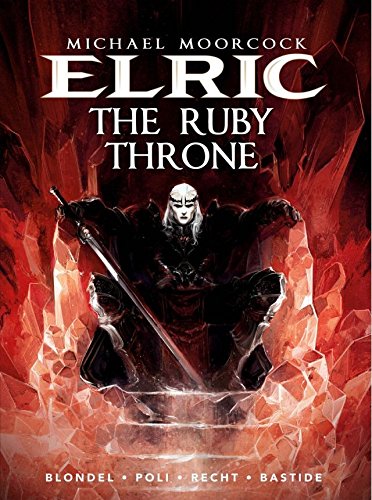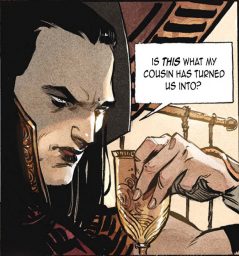
Michael Moorcock’s Elric of Melniboné has enjoyed a storied history in comics. First portrayed in a 1971 bande dessinee, Elric next appeared in America alongside Conan the Barbarian. Over the next forty-five years and more, he has continued to wander from issue to issue and publisher to publisher to the delight of comics readers. Most recently, Elric returned to bande dessinee in 2014’s celebrated Elric: The Ruby Throne, the first of a projected four volume series. Written by Julien Blondel, this adaptation, in the words of Moorcock, “is the saga of the Albino I would have written myself if I had thought of it first.”
The story is simple, but utterly disastrous for all in Melniboné. After millennia of dominance and centuries of decline, Elric, the prophesied last king of Melniboné, sits in a funk on the Ruby Throne, his strength sustained only by foul arcane magics. As his city languishes in a decadence where lifeblood flows freer than wine, his cousin Yyrkoon agitates to Make Melniboné Feared Again. The massing of viking-like barbarians on the seas bring Elric and Yyrkoon to an agreement of purpose, and the cousins rout the invaders. But Yyrkoon used the invasion as a pretext to drown Elric and seize the Ruby Throne. The sea refuses to claim the White Demon of Melniboné, and Elric returns to his home to take back the throne.
The ensuing fight feeds all the souls of Melniboné, slave and slaver alike, to demons.

The Ruby Throne‘s artwork rates among the best I have had the privilege to review. Most of the previous bandes dessinees I have read indulge in vibrant reds and blues. Colorist Jean Bastitde instead makes grey and gold the standout colors of the palette. The illustrations are a collaboration between Robin Recht and Didier Poli, combining both styles in every panel. Stylized fantasy armor and realistic human figures blend together for disturbing portrayals of the callousness around Elric. Moorcock himself prefers this version of Elric as it best captures the casually cruel decadence of Melniboné. Coming from a creative culture that in the 90s wallowed in shock and in the 00s indulged in a penchant for torture porn, I am amazed at the restraint even as I am disgusted by the cruel indulgence in the suffering of others.
Melniboné is the sort of decadently cruel paradise that gets scourged time and again in recent fantasy, such as Red Seas Under Red Skies and even Star Wars: The Last Jedi. Mostly by writers promoting new moralities that lead inevitably toward Melniboné. Whether known as Melniboné, Omelas, or Canto Bight, this aristocratic paradise built on proletariat suffering reoccurs constantly. But the answer proposed to deal with its evil shifts over time, including the oppressed accepting a place as the new oppressors, getting away from it all, reform from within, and destruction from without. Within the context of these stories, this is framed as virtue struggling against vice. From the audience’s seat, more often these stories resemble little more than turf wars as yakuza replaces mafiosi replaces yakuza in a constant wave of rebellion that never stops to consider what to replace evil with, only who gets to push in whose eyeballs and lick clean the blood. (A scene illustrated inside The Ruby Throne.) Moorcock and Blondel avoid the hypocrisy inherent in most versions of this myth by framing it as a civil war among the forces of Chaos, with no respite in the evils inflicted on the servile. There are no righteous here, not one.
I’ll be honest, reading this was like getting an eyeful of Hell, with evil deeds done by evil men for evil reasons. And I know I’m not supposed to like it and that disgust is the intended effect. Demons exist, often in human skin and the talent of Team Elric is to turn craftsmanship towards repulsion and horror without resorting to the grotesque. The result is to turn Melniboné into a more vivid depiction of Hell in comics than that found in the excellent Sandman: Season of Mists. The Ruby Throne is an unsettling read, made even worse by the revelation that Moorcock was struggling with the weighty issues of Britain’s decline and somehow in his search for answers made 2+2 equal 6. I can appreciate the exquisite craftsmanship of the story and the art, both steeped in canons long discarded by our contemporaries. I don’t have to enjoy it, though.
Like with Barracuda, your own enjoyment may well depend on your tolerance of grimdark. Make no mistake, earlier SFF stories are just as violent and dark. But The Ruby Throne replaces the weighty fear of the unknown with the more personal fear of man, and that is a more harrowing thing. I would freely recommend The Ruby Throne to fans of Elric’s print adventures. To those who are more squeamish, or are responsible for children and adolescents, I recommend flipping through an online preview or library copy before purchasing.
No, Thanks.
I know Razorfist praises the Elric series pretty highly. I want to at least read the first book to know if it would be for me or not.
I read the first Elric and couldn’t stand it.
I don’t need all my characters to be good and heroic. And I often like a certain amount of scoundrel in my protagonists but Elric is just a very depressing, cursed character. I got no enjoyment at all from ready about the various ways he dooms himself and anyone he might care about.
I thought the world building was decent and wouldn’t have minded playing an RPG in the world. But that’s as far as I go.
I’ve read Elric since way back and I love the various comic books of it, though IMO the P. Craig Russell ones stand out in my mind.
I love this. Just FYI Elric was meant to be an “Anti-Conan” put in in the height of the “Sword and Sorcery” boom in the 60s-70s. Heh, they even had a comic book crossover in early Conan comics, btw…
So, the “New Wave” was good in that it did start to shake up lots of cliché tropes, countless “I want to make a heroic Sword and Planet, er Sword and Sorcery, er Ray-Gun adventure like -insert famous name here- and 1000 losers after it!”
BUT – it morphed into the bloated and now dying from its own bile monster it is, and all it ended up contributing was things like “Alien” before starting to puke bile on everything. Just the bile was “Politically Correct” flavored so it gots defenders like on BlackGate.com – One Man’s Opinion
Elric first appeared in the 1960s in a series on novellas in the British stf magazine Science Fantasy. To may taste, these are the best Elric stories. As these cover the entire story arc from the fall of Melnibone to Elric’s death, the only thing Moorcock could do in later stories was elaborate the backstory and fill in the ‘cracks’ in the narrative. YMMV, but for me this got old pretty quickly.
Always hated the Elric books. I’ve read most of them decades ago but they don’t stick with me like Tolkien, Howard, or Adams.
Always loved Elric. I’d read Tolkien and Howard and a few other fantasy authors before but it was Elric who made me a serious fantasy fan. Admittedly, this was at the age of 12 (and a proto-emo 12 as well) and I would now admit that Moorcock has significant faults,in particular a weakness for the deus ex machina and a recycling of plots and characters. However, I don’t think there is a better worldcreator in the business. In a few sentences he can create Melnibone in your head, while GRRM for example will take a few books to do so.
Coincidentally, your review arrived on the same day that my Amazon order of the Ruby Throne was delivered. I don’t really like the departures from the original plot which make it seem that everything has to be part of some grand design, while in the original the Young Kingdoms raiders, Straasha were all simply acting out of their own best interests. However, the artist’s feel for Melnibone and the Young Kingdoms is superb.